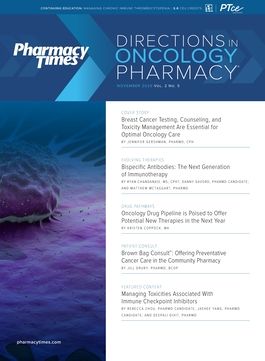Publication
Article
Pharmacy Practice in Focus: Oncology
Practice-Changing Clinical Pearls in Relapsed or Refractory Multiple Myeloma
Three monoclonal antibodies, 1 antibody-drug conjugate, and 1 nuclear export inhibitor have been approved by the FDA for relapsed/refractory (R/R) multiple myeloma in the past 4 years.
PTCE would like to acknowledge GlaxoSmithKline for their generous support of pharmacist education. '
IN A LIVE 2020 Directions in Oncology Pharmacy® conference session, Kathryn Maples, PharmD, BCOP, discussed pivotal changes in the therapy for multiple myeloma (MM) in a presentation titled Multiple Myeloma: Exploring the Rapidly Evolving Treatment Landscape for Relapsed or Refractory Disease. MM is the second most common hematologic malignancy in the United States. The median survival is approximately 5 years, with most patients receiving 4 or more different lines of therapy. Despite major advances in treatment in the past 2 decades, MM remains incurable. Three monoclonal antibodies, 1 antibody-drug conjugate, and 1 nuclear export inhibitor have been approved by the FDA for relapsed/refractory (R/R) disease in the past 4 years.
After a brief review of MM staging, risk stratification, and induction therapy, Dr Maples focused on management of R/R MM. She noted several factors influencing treatment selection include patient age, comorbidities, cytogenetics, timing and aggressiveness of relapse, and response to prior treatments. Dr Maples provided an in-depth review of drug mechanisms of action and clinical trial data in R/R MM, beginning with the use of daratumumab- or carfilzomib-based triplet therapy for treatment of first relapse. She noted second- or later-relapsed disease should preferentially be treated with a clinical trial; however, B-cell maturation antigen (BCMA)-targeted therapy and novel immunomodulatory drugs are also options for consideration. Dr Maples then reviewed newer medications approved by the FDA for R/R MM, including daratumumab, elotuzumab, and isatuximab for third-line therapy, as well as fourth-line FDA-approved therapies such as selinexor and belantamab mafodotin-blmf. She also touched on the phase 3 clinical trial data supporting the use of panobinostat and venetoclax in R/R MM.
Dr Maples emphasized pharmacists can have an integral role in the following aspects of patient care for patients with R/R MM:
- Bone health with zoledronic acid or denosumab
- Venous thromboembolism prophylaxis and treatment recommendations (eg, aspirin)
- Myelosuppression/infection prophylaxis and treatment (eg, use of growth factor support, antimicrobial prophylaxis)
- Renal dysfunction, such as dose adjustments or coordination of administration with dialysis)
Dr Maples provided clinical pearls associated with each class of medications used to treat R/R MM, such as those requiring VTE prophylaxis or management of other toxicities. Differences in dosage forms were also reviewed. The presentation concluded with a review of the pharmacist’s role in managing patients with R/R MM, including education for patients and health care providers; recommending supportive care prophylaxis and treatment; chemotherapy order processing with attention to dose modification based on or gan function, drug−drug interactions and adverse effects; and an emphasis on medication adherence.







